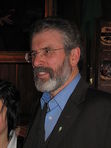Gerry Adams's Blog, page 61
January 16, 2014
Opposing Apartheid
 Mise agus Mustafa Barhgouthi of the PLO Nelson Mandela – Madiba – was the pre-eminent world citizen and his death in December was a moment of great sadness and loss. It also saw worldwide media coverage of his state funeral and almost daily news reports looking back at the struggle against apartheid and Madiba’s role in leading that struggle from inside and outside of prison.
Mise agus Mustafa Barhgouthi of the PLO Nelson Mandela – Madiba – was the pre-eminent world citizen and his death in December was a moment of great sadness and loss. It also saw worldwide media coverage of his state funeral and almost daily news reports looking back at the struggle against apartheid and Madiba’s role in leading that struggle from inside and outside of prison. As regular readers know Richard and I attended the funeral. It was an emotional time. But it was also hugely uplifting. ANC/MK veterans of the armed struggle, political leaders of the new South Africa and comrades from other African states and from liberation movements, spoke of the years of oppression and of war; of imprisonment and protests in the townships; of oppression and resistance. And a consistent theme of all of those reflecting on the decades of conflict was the importance and positive role played by the international community.
This solidarity took different forms.. For some it was about providing practical help and support, like providing passports to allow Mandela and other ANC activists to travel. It also included the provision of logistical and material support to the ANC and also to Umkhonto we Sizwe (MK) – the ANC’s armed organisation which Mandela and others had established.
Speaking at the funeral Tanzanian President Jakaya Kikwete, recalled Madiba’s first visits to that country in 1962. He was there seeking support from Tanzania's first president Julius Nyerere for training camps for MK. Kikwete told mourners that; "Beyond availing places to live and train, he [Nyerere] offered Tanzania's own moral and material support.”
But for most people in Ireland and elsewhere around the world support for the ANC found expression in the numerous anti-apartheid groups that sprang up everywhere. I was one of many thousands who took part in anti-apartheid demonstrations in Dublin. Our task was to raise political awareness about, and to encourage opposition to the apartheid regime. The most effective tactic that the anti-apartheid movement organised was to isolate South Africa through a boycott. This took the form of economic, sporting, cultural, and educational. At every level and in every way there was to be no contact with South Africa – no engagement that would give aid and comfort to apartheid.
In Ireland this was most famously given expression by the Dunnes Stores workers who refused to handle South African produce. But all across the world solidarity organisations marched and campaigned in favour of boycotting South Africa. There were those, like Margaret Thatcher who railed against boycott even claiming that this was hurting the very people oppressed by the white regime’s apartheid policies. But they were a minority.
Those who spoke at Mandela’s funeral; the ANC activists I met; the news reports and documentaries that were broadcast; and the millions of column inches written about Madiba in December; all agreed on the crucial role played by the international community and by the boycott campaign. I tell you all of this because in a recent conversation with Dr. Mustafa Barhgouthi of the Central Committee of the Palestine Liberation Organisation, and member of the Palestinian Legislative Council (Parliament), he described the current situation in that region as ‘a consolidation of a system of apartheid.’
Last summer the United States Secretary of State John Kerry pressed the Israeli government and the Palestinian authority to agree to new peace talks which commenced in August. Media reports say that Mr. Kerry is trying to get Israeli and Palestinian negotiators to agree a framework that would set out the core principles of an agreement. These reports suggest that this would be along the lines of the 1967 border with some land swaps to accommodate settlements.
However there appears to have been little progress and last week the Israeli government announced the construction of 1400 housing units in Jewish settlements on the West Bank and in East Jerusalem. This sparked a sharp rebuke from Saeb Erekat, the senior Palestinian negotiator who said that they, the Israelis, ‘know very well that this destroys the peace process.’ He added that the Israeli announcement showed its ‘commitment to an apartheid regime.’
Mustafa Barhgouthi in his conversation with me before Christmas pointed out that there are now over half a million settlers living on occupied Palestinian land in the West Bank. During the process of negotiations he said that the ‘rate of settlement expansions was 132% higher than in recent years, 550 Palestinians were arrested, while only 52 were released from jails and 24 Palestinians were killed.’
The fact is that there is a significant power imbalance in the negotiations with Palestinians at a serious disadvantage.
In these circumstances the role of the international community is crucial and in this context boycott and sanctions are real levers of pressure.
The EU has a particular role to play in this. Last July it explicitly restated its position that Israeli settlements in occupied Palestinian territory are not considered part of the state of Israel under international law. At the same time there has also been a growing demand for the clear labelling of Israeli products originating in settlements.
On Monday a report in one U.S. newspaper revealed that; ‘An international campaign to boycott Israeli settlement products has rapidly turned from a distant nuisance into a harsh economic reality for Israeli farmers in the West Bank’s Jordan Valley …Export driven income of growers in the valley’s 21 settlements dropped by more than 14% or $29 million, last year.’
In the context of Israel’s £8 billion trade with the EU this is small money but there is no doubt that it is having an impact in some of the settlements and there is potential for it to grow. The South African experience is one example of the positive role that the international community and the effective application of boycott and sanctions can have.
Published on January 16, 2014 12:27
January 9, 2014
Ulster Says NO to Haass!!
The Good Friday Agreement marked a historic shift in politics on the island of Ireland and put in place a firm foundation from which it is possible to continue building the peace process. For the first time since partition, almost 100 years ago, there is an international agreement involving the Irish and British governments, as well as nationalist, republican and unionist parties on a way forward. This includes power sharing political institutions which have the support of the overwhelming majority of citizens.
The GFA tackles constitutional issues, political and institutional matters, policing, weapons, justice and equality, and more. Subsequent agreements at St. Andrews and Hillsborough built on this progress.
However, not all aspects of the Good Friday Agreement have been implemented and outstanding issues like flags and emblems; the legacy of the past; parades; equality and the status of the Irish language, as well as culture and identity issues have continued to bedevil the process.
This time last year Belfast witnessed rioting as loyalists attacked the PSNI, the nationalist Short Strand area; and held illegal demonstrations demanding the right to fly the Union flag whenever and wherever they wanted. This issue and protests over orange parades have placed a significant strain at times on the political institutions.
For that reason and because all of these difficult issues are not going to go away the First and Deputy First Ministers – Peter Robinson and Martin McGuinness – invited U.S. diplomats Richard Haass and Meghan O Sullivan to come to the north and to chair an All Party Group to ‘consider and make recommendations on matters including parades and protests; flags, symbols, emblems and related matters; and the Past’.
Just before Christmas the negotiations entered an intense phase. The Sinn Féin Ard Chomhairle met on December 23rd and authorised our talk’s team to conclude an agreement with the other parties to be considered by a subsequent meeting of the Ard Chomhairle. In the last plenary session, in the early hours of Christmas Eve morning, the Sinn Féin negotiators told the other delegates that ‘we believe there is the basis for an agreement on the mechanisms proposed to deal with the three issues under consideration.’
But despite a succession of amended draft proposals from the two US Diplomats the talks failed to reach agreement. There was a real sense of public disappointment at that outcome, which Sinn Féin shared. Progress had been made and the Sinn Féin negotiating team believed that agreement could be reached.
Unionists indicated that they had serious problems with important parts of the proposals.
However, Richard Haass and Meghan O Sullivan agreed to return for one last push between Christmas and New Year. The negotiations recommenced only to conclude after 5 am on December 31st without agreement. By that stage we had reached the seventh draft of the Haass proposals. Some in the media interpreted this as an abject failure. It wasn’t. The process has not concluded. The Haass proposals have now to be brought to each of the five party leaderships by their negotiating teams. It is up to those leaderships to decide whether the proposals offer another step forward and what should happen next.
In my view significant progress was made and in particular on two of the three issues – Parades, Select Commemorations and Protests; and Contending with the Past and the proposals produced by Dr Haass and Meghan O Sullivan do provide the basis for an agreement.Of course, like every negotiation the document that has been produced is a compromise position. Sinn Féin would like to have seen some aspects strengthened and improved further. However agreement on everything was not possible. This is particularly the case on the Flags issue. Like others we have little confidence that the proposed Commission on Identity, Culture and Tradition will resolve these issues. We nevertheless welcome the potential of this process for further mainstreaming parity of esteem and equality.
I was also disappointed that issues like Acht Na Gaeilge and the development at Maze/Long Kesh which were part of previous agreements, were not advanced. They remain to be resolved in the time ahead. These issues are not going away. Much more work is required on parity of esteem, equality and respect for all cultures and identities.
Sinn Féin has consistently advocated direct meaningful dialogue as the best means of resolving the few remaining parading disputes. In the absence of dialogue or a failure to reach agreement over contentious parades there is an obvious requirement for a robust regulatory body. The proposals contained in the Haass paper meet that demand.
And over a decade ago Sinn Féin proposed the establishment of an Independent International Truth Commission. In our view that remains the best option. But a basis for compromise on this issue has been proposed. That is what the majority of our people want. Closure for victims and survivors is the real benchmark against which this proposition will in time be judged.It is a fact that the issues of parades, flags and emblems and the legacy of the past cannot be ignored. They are too important. There is an onus on the Irish and British governments and all of the parties to maintain the momentum that was created in recent weeks and to build on the progress achieved.
To this end I called for all of the parties not to fudge their response to the Haass proposals. I called for clear statements of support. Regrettably the Ulster Unionist Party and the DUP have decided not to support the proposals. The difference between these two parties is purely tactical. The DUP said more work needed to be done to the proposals and called for an all-party working group to be established while the Ulster Unionist Party has rejected the Haass proposals as neither ‘viable or acceptable’. Two slightly different ways of Ulster Saying No! With Peter Robinson taking a slightly more nuanced position than Michael Nesbitt. Beagandifir. Irish Republicans have stretched ourselves in the negotiations and we are up for the challenge the Haass proposals contain. The Sinn Féin Ard Chomhairle of the Party will meet this Saturday to review the outcome of the talks process, and agree our response.
This is a time for political leaders to lead. Unionist leaders are failing their constituents and ignoring the clear desire by the vast majority of citizens who want to see agreement on these outstanding issues.The Haass paper can aid this project. I would urge anyone interested in the future to access it online, and read and consider the proposals it contains.
Published on January 09, 2014 08:27
January 8, 2014
Leo Wilson - Saying slan to one of the good guys
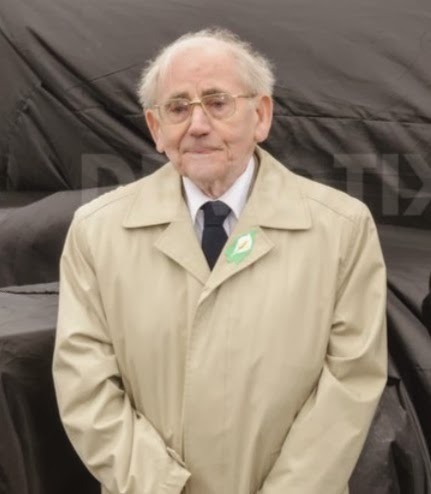
Yesterday I gave the oration at the graveside of Leo Wilson in Milltown Cemetery. Leo died at the weekend at the age of 91. Hundreds of people attended his funeral.
In my oration I said:
“Dia daoibh is mo buiochas do teaglach Leo mar seans s onoir a thug sibh domhsa inniu.
Is mor on onoir domhsa a caint anseo faoi Leo.
Tá fhois agam go bfuil bhur caite briste – go hairithe croi a bhean cheile crogan Maureen.
Caithfid mé a rá go bhfuil a lan daoine bronachinniu.
Caill sibhse dhir fear cheile, bhur dadaí, bhur deideo, bhur daideo mór agus caill muid ar cara.
Leo Wilson was a small man with a great heart and a big vision. He was a family man, a community activist, a lover of music, of flowers, language, sport, talking and dancing. He was a proud republican who loved Ireland. But the love of his life was Maureen.
Leo met Maureen in the 1940s on a bus to Lurgan to support Antrim in a GAA final. Leo was much older than Maureen – he was born on December 3rd 1922 – four days before the Irish Free State came into existence, and was the oldest of a family of 9, reared in Balkan Street on the Falls.
It was a time of great poverty, division, and hardship, especially for nationalists living in Belfast city.
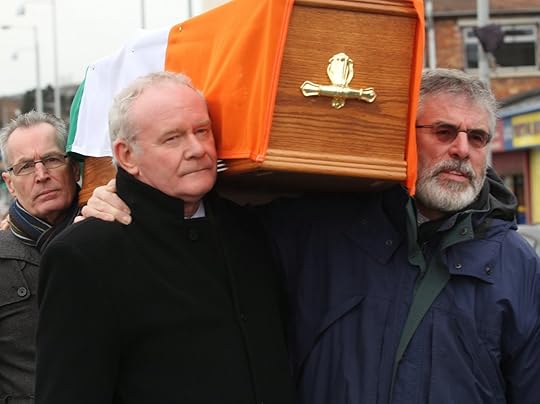 As a young man Leo immersed himself in Conrad na Gaeilge and the Ard Scoil. Around this time he joined the Army. He was of that generation that gave us Tom Williams, Madge McConville, Joe Cahill and Rocky Burns.
As a young man Leo immersed himself in Conrad na Gaeilge and the Ard Scoil. Around this time he joined the Army. He was of that generation that gave us Tom Williams, Madge McConville, Joe Cahill and Rocky Burns. Leo had a great love for Irish history, language and culture. He spent months in the Ranafast Gaeltacht and developed a passion for Céilí dancing. I remember him in the 1960s as a Fear an Tí talking us through the 16 hand reel, the Siege of Ennis, An Caípín Cul Ard and the Walls of Limerick.
He and Maureen were married in 1950 and went on to rear Gearoid, Cormac, Pól, Padraic and Fiona. Ba maith liom mo bhron a thabairt daoibhse, your 10 grandchildren and great grand children and the wider Wilson clann including brothers Billy and Paul and sisters Anne and Mary.
In 1964 when Sinn Féin was banned under the infamous Special Powers Act, Leo was one of 12 republicans who stood as independent Republicans in the general election. He took a remarkable 4,000 votes in South Antrim at a time of widespread oppression by the old unionist regime and the state police – the RUC and its auxiliaries – the B Specials.
 Leo understood the need to make republicanism relevant in the daily lives of citizens. He saw republicanism as a means for building a decent fair society based on citizen’s rights. He knew the value of reaching out to unionists, despite the challenges this presents. He also was about building empowered communities. Leo helped found the Andersonstown Credit Union.
Leo understood the need to make republicanism relevant in the daily lives of citizens. He saw republicanism as a means for building a decent fair society based on citizen’s rights. He knew the value of reaching out to unionists, despite the challenges this presents. He also was about building empowered communities. Leo helped found the Andersonstown Credit Union.He and Moscow Jack Brady formed a branch of the Irish Transport and General Workers Union. He was a founding member of the Roddy McCorley Society and was involved in the civil rights campaign, and in 1969 when the orange pogroms took place, Leo was part of the Citizens Defence Committees that sprang up at that time.
Later as the conflict intensified he joined with Ann and Dessie Murray and Clara Reilly and Frs. Faul and Murray, and Fr. Brian Brady and other great people to form the Association for Legal Justice. For years the ALJ worked tirelessly to help the families of citizens detained by British forces. The ALJ also exposed the torture and brutality of the British Army and RUC during internment.
Later Leo served on the National Smash H-Block Armagh Committee to secure the demands of the Fir Pluid (Blanketmen) in the H Blocks and the women in Armagh prison.
Maureen was active at that time in the Relatives Action Committee in the late 70s and early 80s. During this time the Wilson household suffered house raids, arrests, imprisonment and ongoing harassment by the British Crown Forces and like many other republican families, for the record, we should note that the Wilsons won that battle.
Leo and Maureen also enthusiastically supported the building of Sinn Féin as a radical and competent and principled political party. Leo signed my nomination papers each time I stood in west Belfast and he also was one of Paul Maskey’s nominators. He strongly supported Sinn Féin peace strategy.
 During the negotiations our negotiating team used to meet in houses all across the city. As those who know him will agree Martin McGuinness loves his food and in Leo and Maureen’s they always made great egg and onion sandwiches. So whenever arrangements for a meeting were being made the Wilson’s home was always referred to as the ‘egg and onion.’
During the negotiations our negotiating team used to meet in houses all across the city. As those who know him will agree Martin McGuinness loves his food and in Leo and Maureen’s they always made great egg and onion sandwiches. So whenever arrangements for a meeting were being made the Wilson’s home was always referred to as the ‘egg and onion.’In his 70’s Leo graduated with a degree in political science. He loved learning and books and at the age of 87 he was in the high court in Belfast in defence of library facilities in west Belfast and he and I went to meetings of the Library Board where he articulated the right of citizens to accessible library services.
Leo passed many of his values on to his family. He was a man of faith – and proud of those who gave their lives in the cause of Irish freedom. An active member of the Belfast National Graves Committee last Easter he unveiled the refurbished County Antrim memorial.
Leo is one of the latest of our veterans, heroes from Andersonstown, who we have buried recently. Great people all. People like Mrs Maskey and Mrs Finucane. We are proud of them all. We are proud of Leo and though we are sad at his passing we celebrate his long and useful and happy life.
A last word to the grandchildren. Be proud of your daideo. He was one of the good guys and mind your granny. As Leo would say she was one of the great guys.


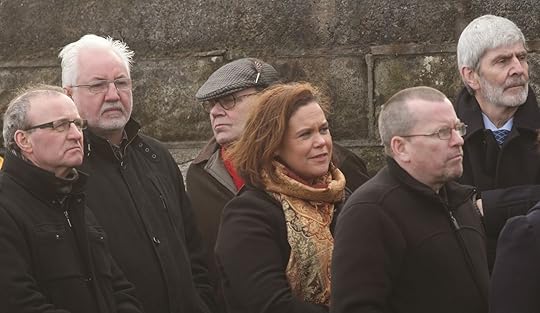
Published on January 08, 2014 01:38
January 4, 2014
Death of Leo Wilson
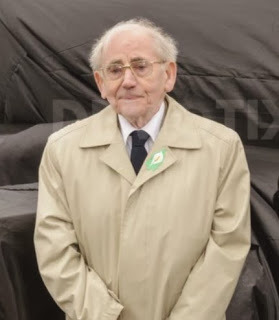
Leo Wilson Leo Wilson died today. On behalf of Sinn Féin I want to extend my condolences to Leo’s wife Maureen, to his sons and daughter Fiona, Cormac, Paul, Gearoid, and Padraic and the entire Wilson clann. Ba mhaith liom mo chomhbhrón a dhéanamh leis an gclann ar fad I Leo Wilson.I have known Leo for a very long time. At 91 Leo was a republican activist for most of his adult life. In October 1964, when Sinn Féin was a banned organisation under the Special Powers Act, Leo was one of 12 republican candidates who stood in the general election. He polled a very credible almost 4,000 votes in the South Antrim constituency. He was active in the civil rights movement and following the pogroms of 1969, the introduction of new repressive laws and the introduction of internment, he and a small number of dedicated human rights workers, including Clara Reilly and Fr. Brian Brady and others, established the Association for Legal Justice and worked tirelessly day and night providing legal advice to families of citizens detained by the British forces. His door was always open to those in need. The ALJ also played a key role in exposing the torture and brutality of the British Army and RUC toward detainees. Leo was a spirited and sprightly soul and an enthusiastic Irish language speaker. He loved Ceilí dancing and often acted as Fear an Tí – calling out the dances. He was one of those who over many elections signed my nomination papers for west Belfast. In his early 70’s Leo graduated with a degree in political science and it was his understanding of the importance of access to books that saw him four years ago in the High Court in Belfast, at the age of 87, in defence of library facilities in west Belfast. Leo was also an active member of the Belfast National Graves Association and last year he unveiled the new County Antrim Memorial in Milltown Cemetery. The stories about Leo’s activism are many. He touched the lives of a huge number of republican activists providing advice, help and even a roof over their heads when they were in trouble. He will be sadly missed by all of us who have the privilege and honour to know him. To Maureen and to his sons and daughter Fiona, Cormac, Paul, Gearoid, and Padraic and the entire Wilson clan, let me again extend my sincerest condolences. Go ndeanfaidh dia trocaire ar a n’anam dílis.
Published on January 04, 2014 15:08
December 27, 2013
Haass Talks: Agreement is Possible
Many people will be disappointed that the all-party talks broke up without agreement for Christmas. Sinn Féin shares that disappointment.
However, it is our view that progress was made and that agreement is possible when the talks recommence.
I want to thank Dr. Richard Haass, Meghan O Sullivan, Charlie Landow and their team, and our colleagues in all five parties represented in the talks.
The Sinn Féin Ard Chomhairle met on December 23rd at my request and authorised our negotiating team to conclude an agreement with the other parties to be considered by a subsequent meeting of the Ard Chomhairle. That remains our firm intention. For this reason we welcome the return of Richard Haass and Meghan O'Sullivan.
Our delegation told the last plenary in the early hours of Christmas Eve that we believed there was the basis for an agreement on the mechanisms proposed to deal with the three issues under consideration.
We would like to see some of these strengthened and have made a number of suggestions on how this can be achieved.
Parades; Select Commemorations; and related protests:
Sinn Féin has always highlighted the imperative of direct meaningful dialogue as the best means of resolving the few remaining parading disputes.
In the absence of dialogue or a failure to reach agreement there is an obvious requirement for a robust regulatory body.
Our negotiating team believes the proposals contained in this paper go a long way in terms of satisfying this.
Flags and emblems:
We are disappointed that a comprehensive agreement on the flags issue has not been reached so far.
Our disappointment will be shared by many who want agreement on the flying of flags on public buildings and the unofficial flying of flags in public spaces.
This is about equality and parity of esteem.
Republicans and nationalists must respect all identities and cultures, including the right of people to identify themselves, and to be accepted as British.
The same respect must be accorded to Irishness, including the right of citizens to use their own language.
A comprehensive agreement is long overdue and that must be our focus but in the absence of a comprehensive agreement the new proposed Commission will provide space for that discussion to take place.
It will allow the opportunity for everyone to bring forward ideas and plans which will see parity of esteem delivered to both British and Irish identities. This would include an Irish Language Act — a modest step which threatens no-one. All of this needs to be done in a sensible and non-confrontational way.
Contending with the Past:
Over a decade ago Sinn Féin proposed the establishment of an Independent International Truth Commission. In our view that remains the best option.
However that approach has not found political agreement in these talks.
But there is acceptance that the status quo is not an option.
A basis for compromise has been proposed.
Closure for victims and survivors is the real benchmark against which this proposition will in time be judged.
This would certainly be our hope.
There is already a widespread acceptance that there isn’t one narrative of our past.
I would not expect unionists or the British Government to embrace the republican narrative and therefore I do not think others should expect republicans to agree to their positions.
We should however accept that all of us have sincerely held views based on the reality of our different experiences and the narratives arising from this.
In conclusion let me say that it would be a matter of grave disappointment for all of those who are dependent on these discussions to build hope and a peaceful future based on equality, if the parties do not find a way to resolve these issues. Failure is not an option.
As the New Year approaches there is a duty and responsibility on all the parties to these negotiations, despite the challenges, to find a way forward.
With a fair wind the proposals under consideration can do this and I would appeal to everyone to overcome any difficulties which may remain.
That is what the greater majority of our people expect.
However, it is our view that progress was made and that agreement is possible when the talks recommence.
I want to thank Dr. Richard Haass, Meghan O Sullivan, Charlie Landow and their team, and our colleagues in all five parties represented in the talks.
The Sinn Féin Ard Chomhairle met on December 23rd at my request and authorised our negotiating team to conclude an agreement with the other parties to be considered by a subsequent meeting of the Ard Chomhairle. That remains our firm intention. For this reason we welcome the return of Richard Haass and Meghan O'Sullivan.
Our delegation told the last plenary in the early hours of Christmas Eve that we believed there was the basis for an agreement on the mechanisms proposed to deal with the three issues under consideration.
We would like to see some of these strengthened and have made a number of suggestions on how this can be achieved.
Parades; Select Commemorations; and related protests:
Sinn Féin has always highlighted the imperative of direct meaningful dialogue as the best means of resolving the few remaining parading disputes.
In the absence of dialogue or a failure to reach agreement there is an obvious requirement for a robust regulatory body.
Our negotiating team believes the proposals contained in this paper go a long way in terms of satisfying this.
Flags and emblems:
We are disappointed that a comprehensive agreement on the flags issue has not been reached so far.
Our disappointment will be shared by many who want agreement on the flying of flags on public buildings and the unofficial flying of flags in public spaces.
This is about equality and parity of esteem.
Republicans and nationalists must respect all identities and cultures, including the right of people to identify themselves, and to be accepted as British.
The same respect must be accorded to Irishness, including the right of citizens to use their own language.
A comprehensive agreement is long overdue and that must be our focus but in the absence of a comprehensive agreement the new proposed Commission will provide space for that discussion to take place.
It will allow the opportunity for everyone to bring forward ideas and plans which will see parity of esteem delivered to both British and Irish identities. This would include an Irish Language Act — a modest step which threatens no-one. All of this needs to be done in a sensible and non-confrontational way.
Contending with the Past:
Over a decade ago Sinn Féin proposed the establishment of an Independent International Truth Commission. In our view that remains the best option.
However that approach has not found political agreement in these talks.
But there is acceptance that the status quo is not an option.
A basis for compromise has been proposed.
Closure for victims and survivors is the real benchmark against which this proposition will in time be judged.
This would certainly be our hope.
There is already a widespread acceptance that there isn’t one narrative of our past.
I would not expect unionists or the British Government to embrace the republican narrative and therefore I do not think others should expect republicans to agree to their positions.
We should however accept that all of us have sincerely held views based on the reality of our different experiences and the narratives arising from this.
In conclusion let me say that it would be a matter of grave disappointment for all of those who are dependent on these discussions to build hope and a peaceful future based on equality, if the parties do not find a way to resolve these issues. Failure is not an option.
As the New Year approaches there is a duty and responsibility on all the parties to these negotiations, despite the challenges, to find a way forward.
With a fair wind the proposals under consideration can do this and I would appeal to everyone to overcome any difficulties which may remain.
That is what the greater majority of our people expect.
Published on December 27, 2013 03:46
December 19, 2013
Saying goodbye to Comrade Madiba
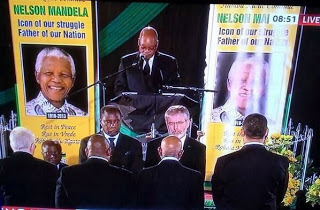 Madiba's Guard of Honour
Madiba's Guard of HonourThe green rolling grasslands of Qunu were coming alive in the early morning dawn light as we climbed down off the bus last Sunday morning. It had been a three-and-a half-hour journey from the airport at East London, in the Eastern Cape, along dark and twisting roads. Qunu is Madiba’s home and it is where he chose to be buried. As the sun slowly lifted itself above the hills, its light revealed a landscape similar to others I have seen in the west of Ireland. A big blue sky and distant homes scattered across hills. It was here that Madiba was born and had grown up. And it was to Qunu he returned. He was home with his clann after nine days of national mourning in South Africa.
Richard McAuley and I had arrived in Pretoria on Thursday. Irish republicans have a long association with the ANC going back many decades. We supported each other in struggle and in our respective efforts to achieve peace. Nelson Mandela and others in the ANC leadership were and are hugely supportive of the endeavours of Irish republicans.It was right and proper that Sinn Féin should be represented at his funeral but it was equally important that we participated as comrades in struggle honouring a comrade for whom we have the greatest admiration and respect.
Lying in stateThe day after we arrived, the ANC brought us to Union Buildings in Pretoria where Madiba was lying in state. Richard and I had been here before several times, meeting Thabo Mbeki in 1995 when he was Deputy President of South Africa and later when Thabo was President. Union Buildings are impressive. It sits on the highest hill in Pretoria looking down on the city. It is the official seat of government and is where the President’s office is located. This month it celebrated its 100 birthday and it was declared on Monday, the day after Madiba’s funeral, as a national heritage site.
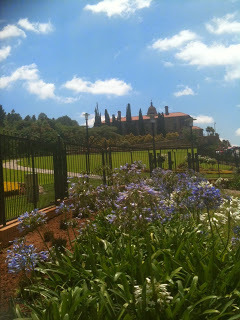
Union Buildings
Between the two wings of the building is a 9,000-seat Greek-style amphitheatre which is used for national ceremonies. Nineteen years ago it was here that Madiba was inaugurated as South Africa’s first democratically-elected President. It was fitting therefore that it was here that a special protective cover was erected within which his body rested and through which two rivers of citizens passed by on either side for three days.
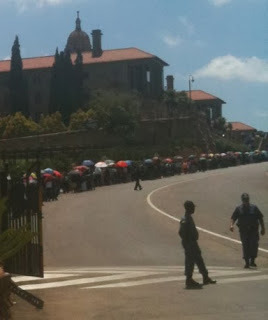
Part of the queue to Union Buildings
The queues of ordinary South Africans stretched for miles, winding their way down the hill and through the streets of the city. They began arriving at 4am each morning and waited patiently in burning heat to pay their respects to their leader. One estimate put the number of people who quietly, sombrely, respectively passed by Madiba during those three days at over one hundred thousand.
We met our ANC comrades at Oliver Tambo Building and were taken directly to the front steps of Union Buildings. We joined in with one of the steadily-moving queues of citizens. Fr Barney McAleer, a Tyrone man who has been in South Africa for almost 50 years, accompanied us.There were four military with rifles pointed down standing at each corner of the coffin. The only sound to be heard was the shuffling of feet as we all solemnly moved forward. One behind the other, we approached his remains. The top of the coffin was opened and under a glass cover could be seen Madiba.
It was an emotional moment, a deeply sad moment. Many of those passing by were crying quietly to themselves. And then we were passed.It was at this place in 1994, as he took on the mantle of President of a free and democratic South Africa, that Madiba said:
“We understand it still that there is no easy road to freedom. We know it well that none of us acting alone can achieve success. We must therefore act together as a united people, for national reconciliation, for nation building, for the birth of a new world. “Let there be justice for all.
“Let there be peace for all. “Let there be work, bread, water, and salt for all…
“Let us as a Rainbow Nation keep this in focus and move forward.”The ‘send-off ceremony’For eight days the South African Government was responsible for the state funeral of their President. But on Saturday, as they prepared to fly him south to Qunu, Madiba’s ‘send-off ceremony’ from Pretoria was given over to his comrades in the ANC and to the veterans of Umkhonto we Sizwe (Spear of the Nation), or MK, the military arm of the ANC, which Madiba founded on 16 December 1961.
The programme began at 5:30am. Robert McBride, a former MK activist and political prisoner, who has been to Ireland many times, drove us to the South African Air Force Base at Waterkloof. A huge air force hangar had been transformed into an auditorium.Two thousand specially-invited ANC and former MK activists, and international guests from liberation and solidarity movements, were present in solidarity with the family, to give an ANC farewell to their former Commander and President.
A space was left in front of a stage for the coffin to sit. As we awaited Madiba’s arrival it was an opportunity to mix and reconnect to comrades we hadn’t seen for a while. Occasionally, groups of ANC activists, many of them elderly women dressed in traditional clothes, would toyi-toyi their way back and forward across the front of the hall, chanting and singing songs of Madiba and of resistance to apartheid. It was a joyous celebration of the life of their leader, of the man they called ‘Tata’, which in Xhosa means ‘father’ and is a term widely used during the 10 days of mourning by political and church leaders, political activists, ordinary citizens and by the media. Madiba was a father to them all.
When his remains arrived at 7am, the South African national flag was removed and replaced by the flag of the ANC. Groups of activists – veterans in the main of the ANC and MK – took turns to provide a guard of honour around the coffin. We were greatly honoured when asked to participate in this. Richard and I took our assigned places and stood silently, paying our private respects to a great leader on behalf of Irish republicans everywhere.Several hours later, after messages of support from the Congress of South African Trade Unions and the South African Communist Party and others, a stirring speech by President Jacob Zuma and much music and song and poetry, the ANC flag was removed, folded and given to the Mandela family. Madiba was then taken from the hall and flown south to his home in Qunu.
Madiba goes homeA few hours after that we took a flight to East London where we met some of the other 4,000 guests invited to attend the funeral. A convoy of buses left the airport around 1am on Sunday morning for the long journey to Qunu. It was impossible to see anything of the countryside. The night was dark and there were few lights along the road except those of our buses.
Sunday was the last day of official mourning. Ten long days for South Africa and ten long days for a grieving family sharing their husband, father and grandfather with the rest of the world.Qunu is an isolated part of the Eastern Cape. For days it had rained and officials were worried that more rain could prove difficult for the funeral arrangements. But as it turned out there was no rain. The day was clear and the sky clear. It was a hot summer’s day when Madiba left his family home for the last time on the journey to the huge Marquee that had been erected to hold his funeral ceremony in.
Walking into this huge space was akin to entering a cathedral. The South African Government had succeeded in creating a beautiful space in which Madiba’s life could be celebrated. The ceiling was high, the air cool, and the colours of the huge lights changed in the course of the ceremony from blue to gold. The centrepiece of the stage was a portrait of Madiba behind 95 candles to mark each of his 95 years.On one side musicians provided music and on the other a choir occasionally raised their voices in song and filled the auditorium with vibrancy and emotion. The event was hosted by Cyril Ramaphosa, who has close associations with the Irish Peace Process. Other contributors included President of Malawi Joyce Banda and Tanzanian President Jakaya Kikwete, who recalled Madiba’s first visits there seeking support for training camps for MK and Kenneth Kaunda, the former President of Zambia.
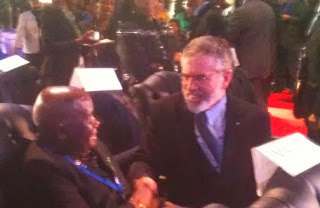
Former President Kenneth Kaunda
They all spoke movingly of Mandela’s contribution to South Africa, to Africa and to the world. They recalled his many qualities and talents. But all stressed the importance of his legacy and the need to live up to the ideals of peace and reconciliation that he exemplified.The most moving speech of those delivered was by his close friend and fellow Robben Island prisoner Ahmed Kathrada, who spent 26 years in prison. Frail and obviously distressed, Kathrada described how he and Madiba called each other ‘Madala’ or ‘Elder’. He said:
“Madala, your abundant reserves of love, simplicity, honesty, service, humility, care, courage, foresight, patience, tolerance, equality and justice continually served as a source of enormous strength to many millions of people in South Africa and the world. “You symbolise today, and always will, qualities of collective leadership, reconciliation, unity and forgiveness. You strove daily to build a united, non-racial, non-sexist and democratic South Africa.”
But at the end his voice broke with emotion as he said:“When Walter [Sisulu] died, I lost a father and now I have lost a brother. My life is in a void and I don't know who to turn to.”
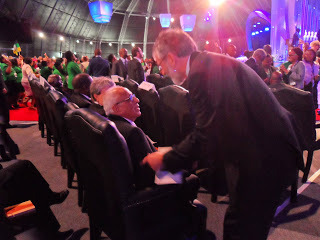 Ahmed KathradaThe gravesideAt the end of the ceremony, Madiba’s remains were taken outside the marquee and placed again on the gun carriage. Most of the 4,000 guests stayed and watched the graveside funeral on the huge video screens above the stage but we were invited to the graveside to watch and mourn as Madiba’s remains were placed in the earth. The language might be different and hymns unfamiliar but as family members placed a flower in the grave and took some dirt to drop in on the coffin the similarities with our own experience in Ireland were obvious.
Ahmed KathradaThe gravesideAt the end of the ceremony, Madiba’s remains were taken outside the marquee and placed again on the gun carriage. Most of the 4,000 guests stayed and watched the graveside funeral on the huge video screens above the stage but we were invited to the graveside to watch and mourn as Madiba’s remains were placed in the earth. The language might be different and hymns unfamiliar but as family members placed a flower in the grave and took some dirt to drop in on the coffin the similarities with our own experience in Ireland were obvious. Madiba’s grave is on top of the hillside in which a small garden has been built. It has a magnificent view of Qunu and of the hills where Madiba played as a boy.
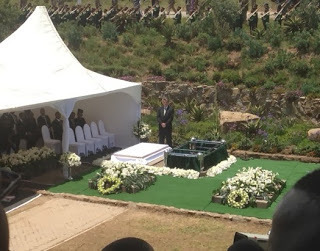
When it was over, Richard and I slowly made our way down the hillside and the bus back to East London.
Madiba is gone. But his words are all around us. The legacy of hope and courage and forgiveness and of reconciliation is one we must aspire each day to achieve. In our several conversations about the Irish Peace Process, Madiba understood at once the complexities but also the only direction we could go to avoid decades more of conflict. He supported the Peace Process in Ireland unequivocally and on the basis of equality and inclusivity. He knew that we all had to be part of solving the problems.
Richard Haass and Meghan O’Sullivan will shortly produce their proposals for moving forward on the difficult issues of flags and emblems and the past. In the days ahead as we seek to find solutions we need to remember the words of Nelson ‘Madiba’ Mandela:
“No one is born hating another person because of the colour of his skin, or his background, or his religion. People must learn to hate, and if they can learn to hate, they can be taught to love, for love comes more naturally to the human heart than its opposite.” ― Nelson Mandela , Long Walk to Freedom
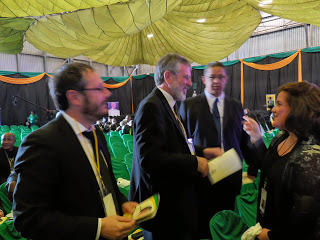 Left to Right: Basque Senator Urko Aiartza, Mise agus Robert McBride
Left to Right: Basque Senator Urko Aiartza, Mise agus Robert McBride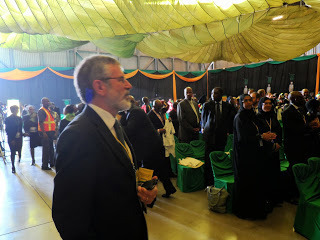
In the South African Airforce Hangar
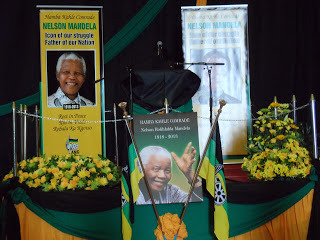 The stage before which Madiba's body lay for his 'send-off'
The stage before which Madiba's body lay for his 'send-off'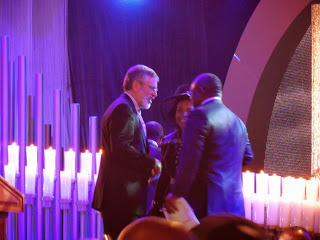
Meeting old friends - Cyril Ramaphosa
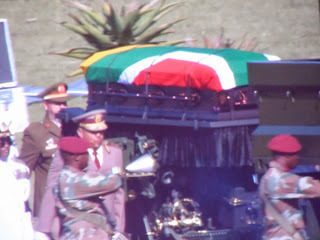
Published on December 19, 2013 03:03
December 18, 2013
The Downing Street Declaration -
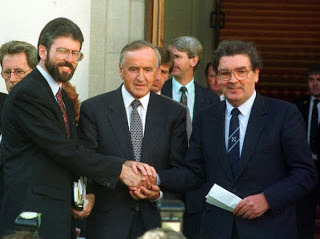 The Downing Street Declaration was 20 years old last Sunday. The first draft of this document was written two years earlier by John Hume as part of secret talks between us aimed at developing a strategy that would provide an alternative to armed struggle.
The Downing Street Declaration was 20 years old last Sunday. The first draft of this document was written two years earlier by John Hume as part of secret talks between us aimed at developing a strategy that would provide an alternative to armed struggle.Sinn Féin’s objective was to get agreement between the Irish government, ourselves and John Hume on the text of a joint declaration and the mechanisms to give effect to this, and to put in place a broad consensus on the Irish nationalist side, including Irish America, to pursue a policy towards peace and justice and to engage with the unionists on this in order to build a peace process.
At that same time alongside the Hume/Adams Talks, Sinn Féin was involved in secret negotiations with John Major’s government, secret negotiations with the IRA, secret negotiations through Fr. Reid with the Irish government, and we were involved in outreach to Irish America and subsequently with the White House. It was a very busy time but progress was lamentably slow.
John gave our draft to Charlie Haughey. The Irish government then produced an unacceptable version which was essentially a rehash of the British and Irish governments position.
At the same time the Irish political and media establishment was engaged in a ferocious campaign of vilification of Sinn Féin – what has changed you ask – which saw Sinn Féin denied the use of the Mansion House and other public buildings for our Ard Fheis.
In January 1993 Albert Reynolds became Taoiseach and introduced a new dynamic into the negotiations. Notwithstanding the shortcomings of this process Mr. Reynolds was by far the best of the Taoisigh to deal with the north.
Charlie Haughey who preceded him had refused to open up talks between his government and Sinn Féin. The delegation which eventually met Sinn Féin was representing Fianna Fáil and not the Irish government, and although that was an important and positive development, there was no real progress made on Mr. Haughey’s watch in terms of an inclusive all-party negotiating process.
Both British and Irish systems had – and still have - one thing in common. They were cautious and wedded to old policies. The Dublin system was also, and remains partitionist, and limited therefore in its thinking and policy development. There were exceptions among the senior civil servants but most of them had spent years dealing with the SDLP and despite Sinn Féin significant mandate they weren’t minded to upset that relationship.
Albert Reynolds had a different style. He brought a directness in how he addressed the potential for progress. Of course he had, as did all Taoisigh, to deal with his own system. The same is true also of British Prime Ministers. Tony Blair has publicly recalled that he was only able to do what he did in 1997 and 1998 because he was a new Prime Minister and it was the heady days of a new government. So too with Mr. Reynolds.
Albert had many contacts in the north from his business activities, including the dance hall business. He had an appreciation of the potential and of course he would have been briefed by his predecessor so he opened his door to Fr. Reid. His coalition partner Dick Spring was much more conservative in his approach. Some of his interventions were unhelpful.
In April 93 the story broke that John Hume and I had been talking and we issued our first joint statement. In it we asserted that the most pressing issue facing us and the people of Ireland was lasting peace and we agreed that a process of national reconciliation was needed.
The result of this was a further barrage of media condemnation, particularly of John. It was vicious. I was regularly subjected to media vilification by that point but for the first time John was the target of a torrent of abuse led by the Independent group of newspapers. Many of the same journalists and columnists have maintained this approach in the following two decades.
The British government, led by John Major, said no to Hume- Adams. The two governments then engaged in a series of rewrites of it.
In November the secret talks between Sinn Féin and the British government became public. At first the British tried to deny it but eventually they were forced to come clean.
The Dublin based papers intensified their attacks on Hume-Adams. John was particularly targeted again. It was almost as if the southern political and media establishment saw him as a traitor to their conservatism. The Sunday Independent in one edition ran 7 separate articles attacking him – some in the most vitriolic and offensive language. After the Shankill bombing and the Greysteel massacre the media onslaught continued. John collapsed and was rushed to hospital. Despite, or, maybe because of, the ferocity of the media attacks nationalist support for Hume-Adams grew.
The British continued to favour inter-party talks without Sinn Féin but Albert Reynolds now indicated his backing for a joint declaration.
The Downing Street Declaration was published on Wednesday 15thDecember with a great deal of spin.
But within hours of it being launched public statements by Reynolds and Major indicated that real differences existed between both governments, not only on the actual meaning of significant and substantial parts of the Declaration, but on its stated objectives.
There was an obvious need for clarification from the governments of what this declaration meant in reality. But John Major rejected my request for clarification declaring that the Declaration was non-negotiable.
In a letter to him I asked that he authorise direct talks with Sinn Fein only in the context of clarification – not negotiation. I spelt out the three main areas of concern for republicans around the Downing Street Declaration. These were: textual matters in the Declaration itself, conflicting interpretations of the Declaration and the processes envisaged by it.
Major didn’t reply. I wrote again in April 1994. A letter from Roderic Lyne, John Major’s private secretary told me to read the Declaration.
Mr. Reynolds then suggested to us that he would seek clarification on our behalf. Martin McGuinness held a series of meetings with Martin Mansergh who was representing the Taoiseach. And the Sagart – Fr. Alec - was constantly on the road between Belfast and Dublin. When clarification eventually came, with the British under pressure responding to 20 questions we had submitted, it supported Sinn Féin’s view that the Downing Street Declaration was in many ways an ad hoc and not so well drafted response to Hume Adams.
The flaws in the drafting were not the fault of the drafters. They were evidence of the different types of pressure on the two governments. So while the declaration was a significant development that was all it was.
Like the Sunningdale Agreement in 1973, and the Anglo-Irish Agreement in 1985, the Downing Street Declaration was intended by the British government and some in the Irish government to be the end of the matter. The line in the sand. And like those agreements before it, it was neither.
Had Sinn Féin accepted the Downing Street Declaration it is arguable that there would never have been a Good Friday Agreement. Bertie Ahern and all involved deserve credit for this accord. But Albert Reynolds was the Taoiseach who welcomed John Hume and me into Government Buildings on September 6th1994.
His wife Kathleen and their family also welcomed me into their home and we enjoyed copious cups of tea during the ups and downs of that time. His was a relatively short term as Taoiseach but Mr. Reynolds ended exclusion, formal censorship and brought the Irish government in from the cold.
Published on December 18, 2013 05:01
December 10, 2013
Nelson ‘Madiba’ Mandela – Freedom Fighter
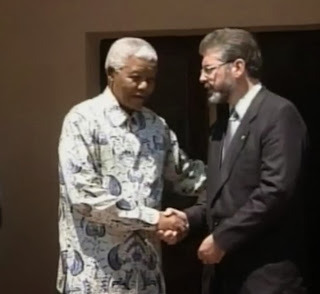 Sinn Féin President Gerry Adams TD speaking in the Dáil this evening on the death of Nelson ‘Madiba’ Mandela said: “Madiba was a leader who by his courage demonstrated that it is possible to reconcile differences.
Sinn Féin President Gerry Adams TD speaking in the Dáil this evening on the death of Nelson ‘Madiba’ Mandela said: “Madiba was a leader who by his courage demonstrated that it is possible to reconcile differences. By his example he showed us that it is possible to build peace out of conflict; something we try to do in our own island; and that a better and more equal future based on fairness is possible, and that unity can be forged out of division.”
The Sinn Féin leader who will be travelling to South Africa tomorrow for the funeral of Madiba reminded the Dáil of the close relationship between Irish republicans and the ANC. He said: “In jail for those decades, on Robben Island, Madiba maintained his international perspective.
In his cell, in common with all political prisoners, he was allowed as a privilege a calendar on which he marked significant events.
On the 5th May 1981 a simple single line is written: ‘IRA martyr Bobby Sands dies.’
A tribute, hand written, on a paper calendar on a cell wall in South Africa which recognises the bond of those who struggle for justice. His note on that prison wall is recognition of the courage and self-sacrifice of the 10 republican hunger strikers of our time. Walter Sisulu later told me that all of the ANC prisoners marked and commemorated each of the hunger strikers who died, including Kieran Doherty TD.”
The full text of Mr. Adams speech:
“Ba mhaith liom mo chombhrón a thabhairt do chlann an iar-Uachtarán Mandela, Uachtarán Zuma, daoine ón Aifric Theas, agus pobal na hAfraice in Éirinn.Taoiseach, Nelson Mandela ‘Madiba’ was truly remarkable.
He was a Freedom Fighter, a political prisoner, a negotiator, a healer, a peacemaker, a father, a grandfather and a husband.
He was a friend to those engaged in the struggle for justice across the globe.
He believed in Ubuntu (we are all interconnected and a person cannot exist separate from society; we all have responsibilities to each other).
He was a friend to the people of Ireland and many people here were his friends, particularly the heroic Dunness Store strikers who took a stand when those in power did not.
The injustice of apartheid was an obscenity – an obscenity to humanity – and in terms of our own experience Vorster – an apartheid Minister in South Africa once said famously that he would swap all of the apartheid laws for one clause of the infamous Special Powers Act in the north.
The ANC was banned, censored and political actions were quashed.
In the 1950’s and early 60’s ANC activists debated how best to challenge the state.
Speaking of that period, Mandela said, ‘We have always believed in non-violence as a tactic; where conditions demanded that we should use non-violence we would do so; where the conditions demanded that we should depart from non-violence we would do so.’
He came to the opinion that the ANC "had no alternative to armed and violent resistance.” His words not mine.In 1961 along with Walter Sisulu and Joe Slovo, Madiba co-founded and became Chairman of the armed organisation Umkhonto we Sizwe (Spear of the Nation), known as MK.
MK engaged in military actions against the South African regime through the period of his imprisonment and following his release.
And in jail for those decades, on Robben Island, Madiba maintained his international perspective.
In his cell, in common with all political prisoners, he was allowed as a privilege a calendar on which he marked significant events.
On the 5th May 1981 a simple single line is written: ‘IRA martyr Bobby Sands dies.’
A tribute, hand written, on a paper calendar on a cell wall in South Africa which recognises the bond of those who struggle for justice.
His note on that prison wall is a recognition of the courage and self-sacrifice of the 10 republican hunger strikers of our time.
Walter Sisulu later told me that all of the ANC prisoners marked and commemorated each of the hunger strikers who died, including Kieran Doherty TD.
Today the world is in mourning.
The people of South Africa have lost their leader, their father and humanity has lost our greatest statesman.
Madiba was a leader who by his courage demonstrated that it is possible to reconcile differences.
By his example he showed us that it is possible to build peace out of conflict; something we try to do in our own island; and that a better and more equal future based on fairness is possible, and that unity can be forged out of division.
In the hard years when the western powers were against him, when he was vilified as a terrorist; when he was denounced as a criminal, he kept the faith.
He showed perseverance and vision.
There are lessons in all of this for us but particularly for the people of the island of Ireland, of all persuasions, as we continue the necessary and challenging task of building the peace.
I first saw Nelson Mandela when he visited Dublin in 1990.
hat was the day the Irish soccer team returned home. And when Madiba appeared a section of the crowd began to chant 'Ooh ahh Paul Mc Grath's Da'.
So, the good humour of Ireland shone through.
In 1995 myself, and several other Sinn Féin activists travelled to South Africa at the invitation of the ANC to speak to senior figures who had been centrally involved in the process of negotiations.
That was when I met Madiba for the first time.
One of the first demonstrations I ever attended was in Dublin against apartheid and the visit of the Springbok Rugby team. And I have been a long-time supporter of the Anti-apartheid movement.
So I was delighted to be meeting with one of my heroes.
During the conflict there was a close working relationship between Irish republicans and the ANC.
And the late Kader Asmal who did tremendous work in the leadership of the Irish anti-apartheid movement, along with his wife Louise, and who was not a supporter of the IRA in his book mentions mentioned by Minister Burton, tells how the IRA provided practical training and advice and assistance with military operations to MK.
Kader says that the famous attack of May 31st 1980 on Sasal Oil Refinery near J’Burg was carried out with the assistance of the Irish Republican Army.
Walter Sisulu, Cyril Ramaphosa, Thabo Mbeki, Ronnie Kasrils and many others who were in the leadership of the ANC were pleased to remember the long commitment, as was Madiba himself, of Irish republicans to their cause.
And of course for our group the highlight of the very intense process of meetings was with Madiba.
He was self-effacing, he was modest, he was totally relaxed and he was very focused.
He was also very tough, stubborn, determined and committed as he needed to be to survive apartheid; to survive over two and a half decades in prison with hard labour.
He was immovable on core principles, on core values, on core issues but pragmatic on tactics and other matters.
It is also interesting that the British government at the time lobbied hard for Madiba not to meet me.
And when it was clear that the ANC was determined and Madiba was determined that the visit should go ahead the British lobbied for no handshake or photograph.
He ignored them.
So, I along with other Sinn Féin representatives have been privileged and deeply honoured to meet Madiba many times after that; in South Africa, here in Ireland and Britain.
Ba pribhiléid mór é dom gur bhuail mé leis cúpla uair.
He was always hugely supportive of the Irish peace process.
On several occasions senior ANC and former MK activists visited Ireland and went into the prisons and talked to republican prisoners about the peace process.
He had an enormous depth of understanding of the twists and turns of our process.
And he knew there was an onus on governments, as well as those involved in struggle, to resolve issues.
I believe as all thinking people believe that there is an onus “to create the necessary environment for peaceful solutions.”
Despite his age and even when I last met with him, despite his increased physical frailty his mind was as sharp as a razor; conversant with world affairs and with the affairs of his own continent, with for example the injustice of the war in Iraq or Afghanistan.
He was a very remarkable human being.
I mo thuairim ba é Nelson Mandela ceann de na ceannairí is fearr a raibh riamh ann. 'Sé mo laoch. Mo Ghile Mear.
All of us remember the very special occasion of the Special Olympics that were held here in 2003.
It was such a marvellous, wonderful historic event and we met afterwards and Madiba was taken by all of the young athletes that he had met in the course of that great event as he was about issues to do with the north, and the need for governments to move on the necessary business of building peace.
He will continue to inspire. He will continue in death as he did while alive to encourage oppressed peoples everywhere.
And in that way his legacy will live on.
You don’t have to be a Nelson Mandela, you don’t have to be a Madiba, we only have to do the small things we can do to make things better for those who suffer from injustice, for those who are deprived, for those who don’t have freedom.
If we all did that in a small way then those heroes like he would not have to do the big things that they have had to do.
Walter Sisulu was a wonderful man. A life long conspirator, political prisoner, and comrade to Nelson Mandela and when he died – any of you have the time you should read Mandela’s farewell – and I repeat just one line of it for this occasion.
Go well, Rest in Peace, Madiba Hero among heroes.
Ar dheis dé go raibh a anam dílis.
Published on December 10, 2013 11:31
December 6, 2013
Comrade Madiba - Nelson Mandela
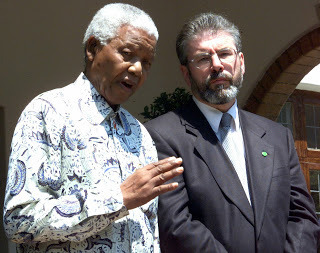
I want to extend to the family of President Mandela, to President Zuma and to the people of South Africa, my sincere and heartfelt condolences at the death of Madiba on my own behalf and that of Sinn Féin.
The world is in mourning. We have lost our greatest statesman. Madiba was a leader who by his courage demonstrated that it is possible to reconcile differences. By his example he showed us that it is possible to build peace out of conflict; a better and more equal future based on fairness, and unity out of division.
In the hard years when the western powers were against him, when he was vilified as a terrorist and a criminal, he kept the faith. He showed perseverance and vision. There are lessons in all of this for us but particularly for the people of the island of Ireland as we continue the necessary and challenging task of building the peace.
I first saw Nelson Mandela when he visited Dublin in 1990. That was the day the Irish soccer team returned home. When Madiba appeared a section of the crowd began to chant 'Ooh ahh Paul Mc Grath's Da'. The craic was ninety. In 1995 myself, and several other activists travelled to South Africa at the invitation of the ANC to speak to senior figures from that party who had been centrally involved in the process of negotiations. That was when I met Madiba for the first time.
It was almost a year after the IRA cessation and just over a year since the first post apartheid election which returned Madiba as President of a Free South Africa. Myself, and several colleagues travelled there at the invitation of the ANC to speak to senior figures from that party who had been centrally involved in the process of negotiations.
The ANC also arranged meetings with representatives from the National Party, General Constand Viljoen leader of the Freedom Front Party and Dr. Niel Barnard the head of the Apartheid regime’s National Intelligence Service.
In developing the Sinn Fein peace strategy toward the end of the 1980s and into the early 1990s Irish Republicans had recognised the importance of the international community as an ally for making progress in a peace process and as a source of inspiration and information for our own endeavours.
While much of our focus was on Irish-America, which had the greatest concentration of the Irish diaspora, Irish Republicans had always had a close affinity with the struggle in South Africa. In my youth one of my first demonstrations was in Dublin against apartheid and the visit of the Springbok Rugby team. I was a long time supporter of the Anti-apartheid movement. The purpose of our trip in 1995 was to learn the lessons of South Africa’s approach to conflict resolution, and to brief people on the difficulties in our process.
Walter Sisulu, Cyril Ramaphosa, Thabo Mbeki, Cheryl Carolus and many others in the leadership of the ANC made us very welcome. However, for all of our group the highlight of our many meetings was with Madiba. He was self-effacing in his humour, totally relaxed and very focused.
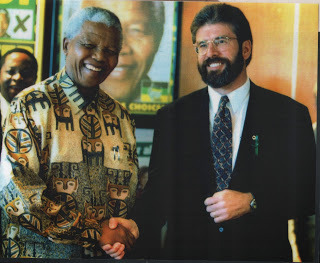 As ever the British government, and sections of the British media, had made much about whether or not there would be a handshake, would there be a photograph and so on. The Major government had lobbied hard for Mandela not to meet me. His response was simply put as we shook hands in his office:
“Ah, comrade Gerry, I’ll not wash my hand for a week.”
Madiba thanked me for the solidarity that Irish republicans had extended to the ANC and the anti-apartheid struggle over many years.
As ever the British government, and sections of the British media, had made much about whether or not there would be a handshake, would there be a photograph and so on. The Major government had lobbied hard for Mandela not to meet me. His response was simply put as we shook hands in his office:
“Ah, comrade Gerry, I’ll not wash my hand for a week.”
Madiba thanked me for the solidarity that Irish republicans had extended to the ANC and the anti-apartheid struggle over many years.It was my privilege to meet Madiba many times after that; in South Africa, in Ireland and Britain. He was funny, engaging and modest and hugely supportive of the Irish peace process. Along with his comrades in the ANC he was very helpful and he had a depth of understanding of the twists and turns of our process.
He was very loyal to those, including Irish republicans who had helped the ANC in difficult times. His outreach to Sinn Féin in the '90's was resisted stridently by the British Government and criticised by sections of the media.
In 2001, on the 20th anniversary of the hunger strike, I travelled to South Africa to unveil a monument to the hunger strikers, in the yard in Robben island prison where Madiba spent much of this time imprisoned. As part of that visit Madiba and I met again and spent several hours talking about the Irish peace process and the changing face of South Africa.
In 2003 he visited Dublin to open the Special Olympics at Croke Park. Martin McGuinness and I met him privately for discussions. Despite his age and increased physical frailty his mind was as sharp as a razor; conversant with the twists and turns of our process as well as the affairs of his own continent or the injustice of the war in Iraq.
Madiba was a very remarkable human being. At our first meeting his commitment to the Irish peace process was obvious. Nelson Mandela remains one of my heroes and in my view the greatest political leader of our time. ‘Se mo laoch. Mo Ghile Mear.’
Madiba will continue to inspire and encourage oppressed peoples everywhere. His legacy will live on.
In the words he used to salute his friend and comrade Walter Sisulu.
Hamba Kahle, Madiba. Qhawe la ma Qhawe!
(Go well, Rest in Peace, Madiba Hero among heroes.)
‘For to be free is not merely to cast off ones chains, but to live in a way that respects and enhances the freedom of others’. Madiba
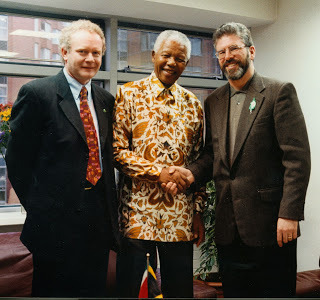
Published on December 06, 2013 07:07
December 5, 2013
What I said reflects what is recorded by Justice Smithwick
Sinn Féin President Gerry Adams TD commenting on criticisms of his remarks on the Smithwick report said:“I am very conscious that at the heart of this issue are two bereaved families. I did not need reminded of this by any of my political opponents and I am concerned, as I was during the Newstalk interview, not to say anything which detracts from that or which causes any further hurt. That was never my intention.What I said reflects what is recorded by Justice Smithwick.So those who attack me are at odds with what is contained in the Smithwick report.It is nonsense to suggest that I was blaming the two RUC officers for their own deaths. Everyone knows the IRA was responsible. That was never in question.There is also no question but that the Smithwick report records serious concerns about the security arrangements for RUC officers travelling to Dundalk through South Armagh. These include the fact that information about possible IRA attacks on RUC officers crossing the border was passed to Garda Headquarters and passed by it to the RUC.It is a fact that RUC Officer Bob Buchanan was crossing the border on average 10 times each month and on most occasions he travelled in his own car which was ‘readily identifiable .’In his report Justice Smithwick records, and I quote, ‘there was a general view that the RUC crossing the border were targets’ and ‘they (referring to RUC members) were all warned in relation to that.’ The Smithwick report records a senior Garda officer “ discussing security with Superintendent Buchanan and asking him “was he happy with coming up without an escort? If you want an escort, we’ll give you an escort. He said he was all right, and that was it.” And there are other examples of concern about the visits across the border by the RUC officers.Clearly, the decision to continue to travel as frequently as they did across the border, without escort, left the RUC officers open to the real possibility of attack.None of this distracts from the tragedy and loss of life. Sinn Féin supported the establishment of the Smithwick Inquiry. I co-operated with the inquiry and met Justice Smithwick and his team and number of times. I have concerns about the Tribunal’s conclusions given that it accepts that it found no direct evidence of collusion and then went on to claim without supporting evidence that ‘on the balance of probabilities’ there was collusion.
Sinn Féin supports the recommendations the Tribunal makes with regard to changes in policing and developing full all Ireland co-operation on policing and justice.There is also a need to deal with the outstanding issues of Weston Park. The Finucane Family are entitled to the same support and levels of disclosure as the Breen and Buchanan Families.A few weeks ago in the Dáil I asked the Taoiseach to facilitate a reasoned and rationale debate on the past. I made the point that the past must not be allowed to become an obstacle to building the peace and a harmonious and fair future for all our citizens.Yesterday’s contrived outburst by the Fianna Fáil leader and the pompous remarks by the Justice Minister and others illustrate the importance of such a debate. Why are they not open to discussing the proposal put by Sinn Féin for a comprehensive, victim centred, truth recovery process under the tutelage of an independent international agency? Could it be that partitionism and revisionism allied with party political self-interest has primacy over more important matters?
Published on December 05, 2013 07:12
Gerry Adams's Blog
- Gerry Adams's profile
- 29 followers
Gerry Adams isn't a Goodreads Author
(yet),
but they
do have a blog,
so here are some recent posts imported from
their feed.


